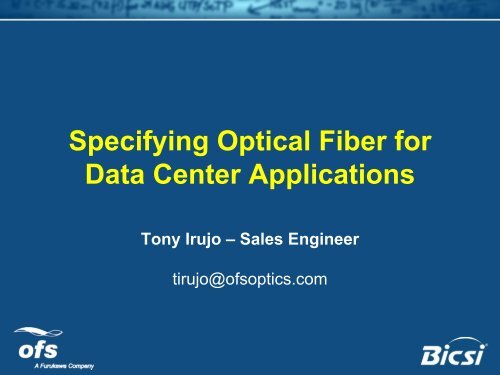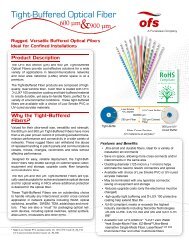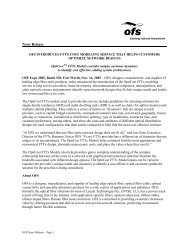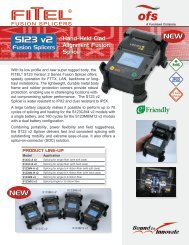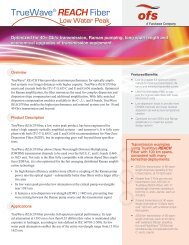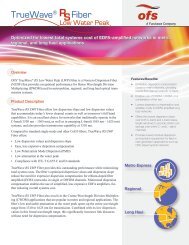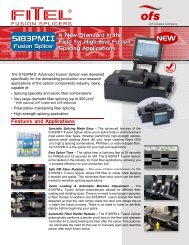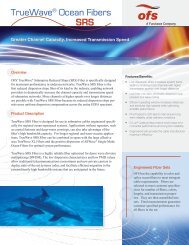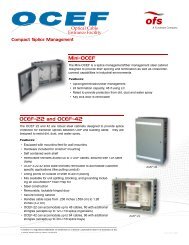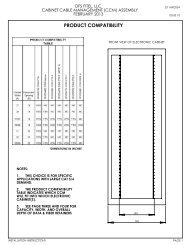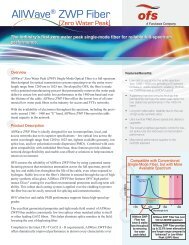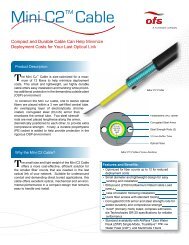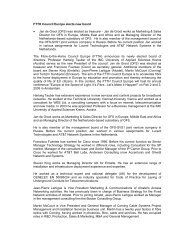Specifying Optical Fiber for Data Center Applications (1.71 MB) - OFS
Specifying Optical Fiber for Data Center Applications (1.71 MB) - OFS
Specifying Optical Fiber for Data Center Applications (1.71 MB) - OFS
You also want an ePaper? Increase the reach of your titles
YUMPU automatically turns print PDFs into web optimized ePapers that Google loves.
<strong>Specifying</strong> <strong>Optical</strong> <strong>Fiber</strong> <strong>for</strong><br />
<strong>Data</strong> <strong>Center</strong> <strong>Applications</strong><br />
Tony Irujo – Sales Engineer<br />
tirujo@ofsoptics.com
Outline<br />
• <strong>Data</strong> <strong>Center</strong> Market Drivers<br />
• <strong>Data</strong> <strong>Center</strong> Trends<br />
• <strong>Optical</strong> <strong>Fiber</strong> and Related Standards<br />
• 40G & 100G Ethernet<br />
• Opto-Electronics and Cabling Considerations<br />
• Conclusions
<strong>Data</strong> <strong>Center</strong> Market<br />
Drivers
IP Traffic Growth<br />
• Global IP traffic will quadruple from 2009 to 2014 –<br />
in other words, the Internet will be 4 times larger!<br />
• Mobile data traffic will double every two years<br />
through 2014<br />
• It will take 72 million years to watch the amount of<br />
video traffic that will cross Global IP networks in<br />
2014<br />
Cisco Visual Networking Index:<br />
Forecast and Methodology, 2009-2014<br />
June 10, 2010
70000<br />
IP Traffic Growth<br />
" Cisco Visual Networking Index (VNI):<br />
Forecast and Methodology, 2009-2014"<br />
June 2, 2010<br />
CAGR<br />
60000<br />
50000<br />
Mobile <strong>Data</strong><br />
Managed IP<br />
Internet<br />
108%<br />
29%<br />
PB/Month<br />
40000<br />
30000<br />
20000<br />
34%<br />
10000<br />
0<br />
2009 2010 2011 2012 2013 2014
Internet <strong>Applications</strong><br />
YouTube<br />
• March 2010 – 24 hours of video uploaded every minute 1<br />
• May 2010 – reaches 2 billion views/day 1<br />
Facebook<br />
Apple<br />
• June 2010 – 400 million active users, spending 500 billion<br />
minutes per month on site 2<br />
• June 2010 – 600,000 iPhone 4’s sold 1st day of presales 3<br />
Apple iTunes<br />
• February 2010 – reaches 10 billion songs sold 4<br />
1<br />
http://mashable.com/2010/05/17/youtube-2-billion-views/<br />
2 http://www.facebook.com/press/info.php?statistics<br />
3<br />
http://www.apple.com/pr/library/2010/06/16iphone.html<br />
4 http://www.apple.com/pr/library/2010/02/25itunes.html
Internet <strong>Applications</strong><br />
http://www.datacenterknowledge.com “Google’s <strong>Data</strong> <strong>Center</strong> Spending Soars”, Oct. 15, 2010
<strong>Data</strong> <strong>Center</strong> Trends
Server growth <strong>for</strong>ecast<br />
Revised with actual 2007-2009 server shipments<br />
20.0<br />
18.0<br />
16.0<br />
14.0<br />
12.0<br />
Robert Hays, Intel<br />
Forecast by Ethernet Connection Type (40G and 100G)<br />
Server Forecast by Ethernet Connection Howard Frasier, Type Broadcom<br />
revised 3/24/10 adjusted to Gartner server volume 2007-2009 and lower growth rate<br />
“40G Ethernet Market Potential”<br />
(revised Mar 2010, adjusted to Gartner volume 2007-2009<br />
IEEE<br />
and<br />
802.3<br />
lower<br />
HSSG<br />
growth rate)<br />
April 2007<br />
100GbE<br />
Hays_01_0407<br />
40GbE<br />
10GbE<br />
GbE<br />
Fast Ethernet<br />
10.0<br />
8.0<br />
6.0<br />
4.0<br />
2.0<br />
0.0<br />
Migration to high speed technology <strong>for</strong> access<br />
links drives need <strong>for</strong> higher speed uplinks<br />
2000<br />
2001<br />
2002<br />
2003<br />
2004<br />
2005<br />
2006<br />
2007<br />
2008<br />
2009<br />
2010<br />
2011<br />
2012<br />
2013<br />
2014<br />
2015<br />
2016<br />
2017<br />
2018<br />
2019<br />
2020
<strong>Data</strong> <strong>Center</strong> Link Speed Evolution<br />
Migration to<br />
16G FC<br />
(OM3 & OM4)<br />
Migration to<br />
40G & 100G<br />
Ethernet<br />
(OM3 & OM4<br />
or SM)<br />
Migration to<br />
10GbE<br />
(<strong>Fiber</strong>, Copper)<br />
<strong>Data</strong> from Alan Flatmann<br />
presented to IEE 802.3 High Speed Study Group<br />
January 2008
Why the higher speeds?<br />
High speed<br />
connections simplify<br />
the network<br />
More interconnects<br />
and switches required<br />
Pictures presented by Adam Bechtel – Yahoo! Chief Architect<br />
IEEE 802.3 Plenary March 2007
Key Network Points <strong>for</strong> 40G & 100G<br />
• Deployment of 40G Ethernet will support primarily Servers<br />
– Interconnection links<br />
– <strong>Data</strong> center servers<br />
– Storage Area Networks<br />
– Corporate, video, medical, R&D Enterprises<br />
• Deployment of 100G Ethernet will be driven by highbandwidth<br />
switching, routing, and aggregation interconnect<br />
points<br />
– Metro, core, carrier/service provider networks<br />
– Internet exchanges and aggregation points<br />
– Will drive growth of Content Provider applications such as:<br />
• Video on demand / IPTV / HDTV / 3DTV, Gaming<br />
– Interconnects <strong>for</strong> high per<strong>for</strong>mance super computing environments<br />
• Not intended <strong>for</strong> riser or horizontal building cabling
<strong>Optical</strong> <strong>Fiber</strong> and<br />
Related Standards
Multimode <strong>Fiber</strong> Types,<br />
Per<strong>for</strong>mance Grades<br />
<strong>Fiber</strong><br />
Type<br />
OM1<br />
62.5 µm<br />
OM2<br />
50 µm<br />
OM3<br />
50 µm<br />
OM4<br />
50 µm<br />
Wavelength<br />
(nm)<br />
850<br />
1300<br />
850<br />
1300<br />
850<br />
1300<br />
850<br />
1300<br />
Max<br />
CABLE<br />
Loss<br />
(dB/km)<br />
3.5<br />
1.5<br />
3.5<br />
1.5<br />
3.5<br />
1.5<br />
3.5<br />
1.5<br />
Min<br />
Bandwidth<br />
(MHz•km)<br />
OFL<br />
BW<br />
200<br />
500<br />
500<br />
500<br />
1500<br />
500<br />
3500<br />
500<br />
E<strong>MB</strong><br />
n.s.<br />
n.s.<br />
n.s.<br />
n.s.<br />
2000<br />
n.s.<br />
4700<br />
n.s.<br />
E<strong>MB</strong> =<br />
OMx designations are from ISO/IEC 11801<br />
International Cabling Standard<br />
OFL BW =<br />
Overfilled Launch Bandwidth<br />
Effective Modal Bandwidth<br />
(also known as “Laser” BW)
Multimode <strong>Fiber</strong> Standards<br />
ISO / IEC<br />
11801<br />
OM1<br />
(62.5 µm)<br />
OM2<br />
(50 µm)<br />
OM3<br />
(50 µm)<br />
OM4<br />
(50 µm)<br />
TIA / EIA<br />
492AAAA<br />
492AAAB<br />
492AAAC<br />
492AAAD<br />
IEC<br />
60793-2-10<br />
A1b<br />
A1a.1<br />
A1a.2<br />
A1a.3
Multimode <strong>Fiber</strong> Per<strong>for</strong>mance (10G)<br />
by Type & Grade<br />
Reach & Bandwidth by MM <strong>Fiber</strong> Type<br />
Reach (at 10 Gb/s)<br />
Bandwidth (at 850nm)<br />
Reach<br />
(meters, at 10 Gb/s)<br />
600<br />
500<br />
400<br />
300<br />
200<br />
100<br />
5000<br />
4000<br />
3000<br />
2000<br />
1000<br />
Bandwidth<br />
(MHz-km, at 850nm)<br />
0<br />
62.5 um<br />
50 um<br />
50 um<br />
50 um<br />
0<br />
OM1<br />
OM2<br />
OM3<br />
OM4<br />
<strong>Fiber</strong> Type ( ISO Grade )
OM4 Specifications<br />
• Effective Modal Bandwidth (E<strong>MB</strong>) >/= 4700 MHz-km<br />
– Allows 2 methods <strong>for</strong> verification– DMD Masks or E<strong>MB</strong>c<br />
• OFL Bandwidth at 850nm >/= 3500 MHz-km<br />
– Ensures per<strong>for</strong>mance with sources that launch more power into<br />
outer modes<br />
• OFL Bandwidth at 1300nm >/= 500 MHz-km<br />
– Ensures backward compatibility with OM1, OM2, OM3 fibers <strong>for</strong><br />
applications such as FDDI, 100BASE-FX, 1000BASE-LX, etc.
Why is OM4 important?<br />
<strong>Fiber</strong> dominates in Access to Distribution and Distribution to Core links.<br />
OM3 <strong>Fiber</strong> only supports < 90% of Links<br />
89%<br />
85%<br />
100<br />
100<br />
Alan Flatman – Principal Consultant, LAN Technologies, UK<br />
“Long <strong>Data</strong> <strong>Center</strong> Links vs. Length”<br />
IEEE802.3ba, Jan. 2008, Flatman_01_0108
Why is OM4 important?<br />
<strong>Fiber</strong> dominates in Access to Distribution and Distribution to Core links.<br />
OM4 <strong>Fiber</strong> supports 95%+ of Links<br />
> 98%<br />
~95%<br />
150<br />
150<br />
Alan Flatman – Principal Consultant, LAN Technologies, UK<br />
“Long <strong>Data</strong> <strong>Center</strong> Links vs. Length”<br />
IEEE802.3ba, Jan. 2008, Flatman_01_0108
Singlemode <strong>Fiber</strong> Types<br />
<strong>Fiber</strong> Type Wavelength<br />
(nm)<br />
OS1<br />
OS2<br />
Low Water<br />
Peak<br />
1310<br />
1383<br />
1550<br />
1310<br />
1383<br />
1550<br />
Max CABLE<br />
Loss<br />
(dB/km)<br />
1.0<br />
---<br />
1.0<br />
0.4<br />
0.4<br />
0.4<br />
OSx designations are from ISO/IEC 11801<br />
International Cabling Standard
Singlemode <strong>Fiber</strong> Standards<br />
ISO / IEC<br />
11801<br />
TIA / EIA<br />
IEC<br />
60793-2-50<br />
ITU-T<br />
OS1 492AAAA B1.1 G.652.A or B<br />
OS2<br />
(Low Water Peak)<br />
492AAAB B1.3 G.652.C or D<br />
--- --- ---<br />
G.657<br />
(Bend Insensitive)
40G & 100G Ethernet<br />
IEEE 802.3ba
IEEE 802.3ba 40G & 100G Ethernet<br />
40G – <strong>for</strong> Servers, Access<br />
– 10 km over single-mode fiber (1310 nm) 40GBASE-LR4<br />
– 150 m over OM4 multimode fiber (850 nm) 40GBASE-SR4<br />
– 100 m over OM3 multimode fiber (850 nm) 40GBASE-SR4<br />
– 7 m over copper 40GBASE-CR4<br />
– 1 m over backplane 40GBASE-KR4
IEEE 802.3ba 40G & 100G Ethernet<br />
100G – <strong>for</strong> Switching, Routing, Aggregation<br />
– 40 km over single-mode fiber (1310 nm) 100GBASE-ER4<br />
– 10 Km over single-mode fiber (1310 nm) 100GBASE-LR4<br />
– 150 m over OM4 multimode fiber (850 nm) 100GBASE-SR10<br />
– 100 m over OM3 multimode fiber (850 nm) 100GBASE-SR10<br />
– 7 m over copper 100GBASE-CR10
Short Reach Multimode:<br />
Multiple <strong>Fiber</strong> Parallel Systems<br />
<strong>for</strong> 40G:<br />
• One 12-fiber cable<br />
– 8 active fibers<br />
– Duplex link<br />
• One wavelength per fiber<br />
• 4 x 10 Gb/s<br />
• 12 <strong>Fiber</strong> MPO connector
Short Reach Multimode:<br />
Multiple <strong>Fiber</strong> Parallel Systems<br />
<strong>for</strong> 100G:<br />
• Two 12 <strong>Fiber</strong> Cables, or<br />
24 fiber Cable<br />
– 20 active fibers<br />
– Duplex link<br />
• One wavelength per fiber<br />
• 10 x 10 Gb/s<br />
• MPO connector<br />
– 2 x 12 fiber<br />
– 1 x 24 fiber
40G & 100G Ethernet – MDI Recommendations<br />
References MPO interface req’s/specs of IEC 61754-7<br />
40GBASE-SR4 :<br />
100GBASE-SR10 :<br />
Option A<br />
(recommended)<br />
o o o o o o o o o o o o<br />
Tx Rx<br />
Option B<br />
o = unused<br />
Option C<br />
Rx<br />
Tx<br />
o o o o o o o o o o o o<br />
o o o o o o o o o o o o<br />
o o o o o o o o o o o o<br />
Tx<br />
o o o o o o o o o o o o<br />
Rx<br />
o o o o o o o o o o o o<br />
o o o o o o o o o o o o<br />
Rx<br />
Tx
IEEE802.3ba<br />
40 & 100 Gb/s Ethernet<br />
• Reduced Reach (from 10Gb/s) on OM3<br />
due to relaxation in transmitter<br />
spectral width:<br />
– from 0.45 to 0.65 nm<br />
• 150 meter reach on OM4 requires<br />
connection / splice loss ≤ 1.0 dB
What is Skew ?<br />
• Skew<br />
– Difference in arrival time<br />
Skew<br />
• What are “typical” numbers<br />
<strong>for</strong> skew in a 100 meter<br />
cable?<br />
– Ribbon: 0.3 ns<br />
– Loose tube: 0.8 ns<br />
–Two primary reasons<br />
• Differential fiber length in<br />
a cable<br />
• Numerical aperture<br />
Source:<br />
Alfred Flores, RCDD<br />
Berk-Tek, a Nexans Company<br />
“40/100 Gb/s Ethernet Over Multi-mode <strong>Optical</strong> <strong>Fiber</strong>”<br />
January 2009<br />
Winter BICSI Conference
Is Skew Important?<br />
• Not <strong>for</strong> fiber-based parallel transmission<br />
– 40G & 100G Ethernet requirement is 79 ns<br />
– Fibre Channel is using serial transmission<br />
– Infiniband specification has a tight skew requirement<br />
(0.75 ns) that assumes the presence of repeaters in<br />
the link. Repeaters are not required <strong>for</strong> 100 meter<br />
multimode links.<br />
– Both ribbon and loose tube cables support Ethernet,<br />
Fibre Channel and short reach Infiniband needs
Long Reach Singlemode:<br />
Wavelength Division Multiplexing<br />
4 Different<br />
Lasers<br />
Combiner<br />
Splitter<br />
4 Detectors<br />
Cladding<br />
For 100G<br />
• 2 <strong>Fiber</strong> Cable<br />
• Multiple Lasers and Detectors<br />
• 4 x 25 Gb/s
Fibre Channel, InfiniBand<br />
• FibreChannel (FC)<br />
– <strong>Data</strong> <strong>Center</strong> Storage Area Networks<br />
– Migration path:<br />
• 8G (FC-PI-4) 16G (FC-PI-5) 32G (FC-PI-6)<br />
• All serial transmission<br />
– Will require OM3 & OM4<br />
• InfiniBand<br />
– Primarily used in High Per<strong>for</strong>mance Computing (HPC)<br />
– Migration from 2.5Gb/s 10 Gb/s 40/100 Gb/s<br />
– Parallel transmission paths <strong>for</strong> 40/100 Gb/s
Opto-Electronics &<br />
Cabling Considerations
Transceiver Considerations<br />
• Moving to array-based, parallel<br />
transmission over multimode<br />
• Tx mfr’s focused on creating lowercost<br />
850 nm based transceiver<br />
arrays <strong>for</strong> short-reach applications<br />
• Increase mfg yield by relaxation of<br />
spectral width requirements
System Considerations<br />
• Transceivers<br />
– Will leverage existing fiber and<br />
transceiver technologies<br />
• 850nm Parallel VCSEL Arrays<br />
• 1310 nm CWDM Transceivers<br />
• Good reference: TIA TSB-172<br />
• Multi-fiber Connectivity<br />
– MPO cable terminations<br />
– SNAP12 Tx connections
Cabling Media Trends<br />
• <strong>Data</strong> centers largest growth area in enterprise cabling<br />
• Rapidly moving from copper to fiber cabling<br />
• Historically, ~80% copper (familiarity, cost per port, copper cabling<br />
companies)<br />
• Typical cabling lengths →60-90 meters<br />
• This mix has more fiber <strong>for</strong> the high end data centers (70% or more fiber)<br />
• Considerations favoring fiber<br />
• Prices of fiber cable and optical ports decreasing<br />
• Price, size, power consumption of copper cable increasing<br />
<strong>Fiber</strong> supports GREEN-friendly solutions<br />
• 40 and 100 Gb/s over copper limited to 7m
Cabling Media Trends<br />
• <strong>Optical</strong> Cabling Systems<br />
• ~80% multimode fiber, 20% single-mode<br />
• Pre-terminated multi-fiber trunk cables to interconnect racks<br />
• MPO connectors and cassettes<br />
• Optimum solutions OM3 and OM4<br />
• Supports evolution in transmission speeds<br />
• Maintains multimode cost benefit over single-mode<br />
• Super-Computing market driving towards 24 fibers / link,<br />
100 Gb/s OM3 & OM4 solutions
<strong>Fiber</strong> / Cabling Considerations<br />
Multimode <strong>Fiber</strong> Counts<br />
– 12 fibers required <strong>for</strong> duplex 40G link<br />
(8 active)<br />
– 24 fibers required <strong>for</strong> duplex 100G link<br />
(20 active)
Plug & Play <strong>Data</strong> <strong>Center</strong> Systems<br />
High <strong>Fiber</strong> counts and lower installation costs<br />
LC<br />
Hub<br />
MPO<br />
Modular<br />
pre-terminated<br />
optical cassette<br />
systems<br />
Backbone<br />
Cable<br />
MPO<br />
Switch<br />
LC<br />
Patch panel<br />
(interconnect)<br />
LC
Cost Comparison between Single-mode<br />
and Multimode <strong>Fiber</strong> Systems<br />
Traditionally, optoelectronics have driven the cost<br />
difference between single-mode and multimode<br />
• Single-mode CWDM system<br />
Pro – Lower cable cost<br />
Con – Significantly higher transceiver cost<br />
• OM3 and OM4 multimode parallel systems<br />
Pro – Much lower transceiver cost using existing 10Gb/s VCSELS<br />
Con – Higher cabling cost
40G Systems Cost Comparison between<br />
Multimode and Single-mode<br />
> 3x<br />
SM<br />
MM<br />
Paul Kolesar, CommScope, “The Case <strong>for</strong> Extended Reach Multimode Objectives”<br />
IEEE 802.3ba, September 2008, Kolesar_01_0908
100G Systems Cost Comparison between<br />
Multimode and Single-mode<br />
> 10X!<br />
SM<br />
MM<br />
Cabling costs insignificant compared to optoelectronics<br />
Paul Kolesar, CommScope, “The Case <strong>for</strong> Extended Reach Multimode Objectives”<br />
IEEE 802.3ba, September 2008, Kolesar_01_0908
Cost implications (40G & 100G)<br />
Copper<br />
OM3<br />
OM4<br />
SM<br />
Distance<br />
7m<br />
100m<br />
150m<br />
10 km<br />
Transceiver<br />
CAPEX<br />
Cable cost<br />
CAPEX<br />
Power use<br />
10+ w ?<br />
Conclusions<br />
• <strong>Data</strong> centers are shifting from copper to fiber<br />
– Copper is more costly and has limited transmission distance<br />
– <strong>Fiber</strong> has much lower power consumption<br />
• OM3 and OM4 Multimode fiber will play an important roll<br />
in 40-100 Gb/s transmission rates in data centers<br />
• OM4 is well accepted and has been incorporated in<br />
system standards<br />
• There will be a shift to parallel transmission over<br />
multimode with MPO connections


